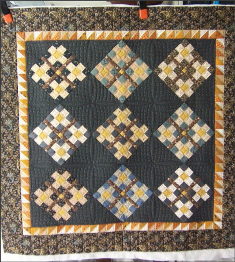Miniature quilts

Mini quilts are a wonderful way to accomplish a particular pattern or technique without investing lots of dollars into fabric and batting. However, miniature quilts don’t necessarily cut down on the investment of time. Some miniature quilts under 12 inches square have over 1,000 pieces of fabric in them! That’s enough to make your head spin around twice.
While quilters and “experts” argue about what truly qualifies as a miniature quilt, your definition is the only one that really matters … after all, you’re the one who will use it! The only exception is if you decide that you want your miniature quilt entered in a contest or show. In that event, read the rules and directions very carefully regarding “scale” and finished size. Many shows classify miniature quilts at a maximum of 24 inches on a side, with the maximum block size at 4 inches square.
Accuracy in miniature quilts is one of the most important aspects. The smaller the block, the more important it becomes. You know how even a slight seam allowance difference magnifies trouble in larger quilts … in miniatures, even a 1/32-inch variation can create problems. To improve accuracy, use the same brand of rulers throughout the project. Choose one with very thin lines to eliminate the guessing that can come from wider lines.
Make sure your seam allowance is set up to sew an exact 1/4-inch seam. Press fabric thoroughly before cutting, and consider spray-starching the fabric slightly for more accurate cutting. Pay attention to fabric grain to avoid stretching. All outer block edges should be on the straight-of-grain. After construction, grade your seams only where too many come together to lie flat.
As for the quilting, it may seem a bit like overkill to mount a miniature to a longarm frame. However, even small pieces can be quilted very well on longarms. In fact, it often results in a better finished piece, because the backing and fabric can be held squarely while stitching. If you use a domestic machine to quilt a miniature quilt, pulling and pushing the fabric can distort seams and blocks.
To hold the side edges of miniatures securely on a longarm, switch from your standard side clamps to an old-fashioned method used in traditional sit-down frames. Tear a long length of fabric along the lengthwise grain (selvage works great for this). Wrap one end around your end arm or leg of the machine and pin it to itself to hold it in place. Pull the free end over to the quilt and pin it in place. The fabric will not stretch so it will allow you to put pressure on the quilt to hold it in place, but it won’t allow you to pull too much to distort it like the standard clamps may.
As another option, you can “reverse” your clamp and pull the loose elastic end over to the quilt and pin it in place. Adjust your clamp buckle until the elastic keeps the fabric smooth but not distorted. The regular clamp will simply hang down on the frame and won’t be used. In fact, this trick works very well whenever you may run into your clamps with the sewing head … “reverse” the clamp and attach the elastic to the backing. No sag, and no lip to catch on!
Quilt by Linda Rech.



